As I prepared to dive into the topics of Africa’s mythology for the sake of tour of the world’s mythologies, I wondered whether or not I should actually cover Egypt. Egypt, being so closely associated to several empires that formed around the Mediterranean and Middle East, is one of the few places in Africa that we are familiar with in some fashion. But as I was considering it I realized that, despite our familiarity with who they are, we really have very little clue when it comes to their ancient religion.
In the west, we all know a few things about Egypt. First, we know they built pyramids and a sphinx that are iconic and have existed for so long that we wonder why we can’t get a cell-phone battery that doesn’t flake out on us in the modern day. Second, they believed cats were sacred, setting up the ground work for the internet as we know it. Third, they lived on the River Nile. Fourth, Cleopatra was, for a time, queen of the Nile, or queen of denial, depending on who you ask. And fifth, they worshipped the sun because you don’t want to anger that thing while living in the desert.
So, in the spirit of “the wisest man is the one who admits he knows nothing” I will now show you a handful of elements from Egyptian mythology that we in the west typically don’t hear anything about. So let’s begin today’s Alternate Mythology…
Egypt: More Than Ra And Anubis
The kingdom of Egypt was actually more of a collection of city states and cults that happened to all live along the Nile. Though they eventually united and began creating the awesome things that we’ve found, their earlier roots show through in the diversity of their gods which often were treated only as regional deities and had many cults which existed side by side over the centuries. In fact, the power dynamic between these cults were so balanced that often new leadership would appear and place their god as the greatest god or the creator god, resulting in Egypt having several creator gods. Despite this, most westerners could really only name a couple off the top of their heads and most would start to get a little rough around the edges after Ra, Anubis and Apophis (and I can’t guarantee everyone reading this knows that last one).
Since I don’t have the time, space, or knowledge to name every single Egyptian god out there, I’m going to point out a few of them that caught my attention just to give you a sense of why. If you’re a fantasy writer, Egyptian might be the mythology for you because this is a mythology that can’t be screwed up (as you’ll see later). First, let’s start with something that only a select region of the world could produce.
Taweret
As I’ve said repeatedly over the course of covering mythologies, the people who create folklore often do so to craft stories about what they fear. For the Europeans the great fear was often barbarians coming to burn down the village and thus you’d have many creatures who could breathe fire, especially those which would eventually become part of heraldry. But in Egypt, on the Nile, there was something a lot more likely to ruin your day.
The Hippopotamus is the second deadliest animal on the African continent. Despite its cute little ears and somewhat jolly appearance it’s a berserk asshole and the only thing in Africa to kill more people is the Mosquito thanks entirely due to infectious diseases. As such, the Hippo is more dangerous than the crocodile, lion and everything else you could picture would ruin your day in Africa. A leading cause of this is their complete lack of need for provocation and tendency to simply be hyper territorial and built like a god damn tank.
Today, the Hippo is found mostly in Sub-Saharan Africa, far from the Nile river valley. However, in the time of ancient Egypt they were quite common in the Nile and were actually seen as the embodiment of chaos as they attacked boats and people who got too damn close with absolutely no care. Ruling parties even went so far as to hunt the Hippo for some reputation of strength, much like today’s politicians sniping wolves from helicopters. But the fact remained that a leader required a team to take down one Hippo while that same Hippo could probably decimate a village if it was too damn close. So of course the Egyptians turned this into a protective god… because if it’s going to maul someone it might as well not be you.
Taweret is an Egyptian goddess of fertility and childbirth, amulets of her were used to protect households, new mothers and the human race as a whole. The reason for this was simple, while male Hippos are just angry assholes of the animal kingdom, the female Hippos could be understood to be protecting their young when they went berserk. In this aspect, Taweret and SEVERAL other goddesses were based on Hippos and credited with the motherly defense of all who worshipped her.
The description of Taweret is primarily that of a bipedal Hippo, but her body has traits lifted from other animals and blended in. She has the back of a Crocodile, the breasts of a human and paws of a lioness. These features are to show her more aggressive fertility goddess stature. While most European fertility goddess were there to ensure good health and improved crops, Taweret and other Egyptian Hippo goddesses were there to destroy anything that may threaten those things with extreme prejudice.
Which is actually a theme that a lot of Egyptian goddesses shared, such as…
Neith
At first glance, Neith is your typical goddess type, armed with a loom, she’s a goddess of “domestic arts” such as weaving and nursing. In the later times she became associated with the waters of creation that spawned the world and the Nile while simultaneously sometimes being the mother of Ra himself. In this way she’s like every other goddess of mothers and perfectly “domestic”…
Except she’s also a goddess of war.
Being the mother goddess, one of the forces of creation to bring the world into being and yet also willing to hunt like Artemis and go to war like Ares and Athena is one of those aspects of Egyptian mythology you have to admire. Because their mythology was constantly evolving, goddesses like Neith were given new roles as they adopted the place of other figures and were given new traits by their sects trying to further connect them to the mythos. Before long, you find that you have a woman who can weave fabrics and then use the leftover thread to string a bow and go kick some ass.
And Neith isn’t alone. In Egypt, other goddesses of war were Bast (a cat-headed goddess), Menhit (a lioness goddess known for massacres), and Sekhmet (ditto). Essentially, Egypt believed that women were capable of being fierce warriors and placed goddesses at the head of warfare multiple times, often associating with the lioness due to their nature as hunters and protectors of the pride.
Another curious thing about these goddesses is that, often, when they became important enough, they were soon associated with the sun in one way or another. As Neith became the mother of the sun, Sekhmet became the daughter of the sun. This was a common theme in Egypt and almost everything, in one way or another, was connected to either the Nile, the Sun, or both.
And when I say everything, I mean everything, as that also included…
Khepri
Khepri was the Scarab-headed solar deity tasked with moving the sun across the heavens or even with building the sun itself before it began to travel. This belief was rooted in the behavior of the Scarab, a sacred creature to the Egyptians, more commonly known by the west as the Dung Beetle, which rolls spheres of dung for their larvae and emerge from these dung spheres as adults after they’ve matured. This resulted in the visual of the Scarab god creating the sun, moving it across the sky and possibly being born from it.
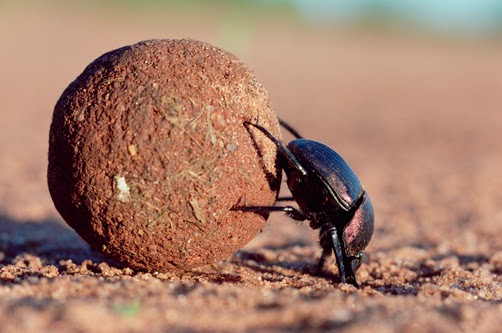 |
| It’s like Katamari Damacy… with crap |
But Khepri’s role as the one who creates and pushes the sun across the sky means he’s not actually worshipped as a singular deity but rather as either a servant to or aspect of a greater deity. Khepri has no cult of his own, instead being often seen as Ra’s personal servant who pushes the sun much like Apollo’s chariot would pull it. In other interpretations he is Ra himself in a new form to suit the task of bringing the morning sun to the world and then starting its journey across the heavens.
And in this fashion, Khepri is given a great deal of credit for a force the Egyptians greatly respected and yet… given absolutely no credit at all. He is the minion, the grunt, or just some projection of another god’s power. And this entire time he goes about pushing a terribly hot ball composed of flaming dung (which, actually, is a fairly good fuel source if you’re in a pinch).
Khepri’s life is woe, thankless woe. And that’s all thanks to the existence of…
Ra (and his many personalities)
So I know I titled this “more than Ra and Anubis” but it’s hard to escape him (as you’ve no doubt noticed by now). Ra is one of the most likely gods to be connected or overlapped with everyone else because all things in Egypt circled the things that they either feared or respected. The sun, seeing that Egypt was a desert nation, was something that the Egyptians knew was a powerful force in their lives. Anyone who doubted this could just step outside for a while and remember that the thing was a powerful ball of unbridled energy.
 |
| That hates you. |
But here’s the thing, the Nile river valley had many solar deities and as the different gods became popular they in turn became solar deities themselves. So as Egypt went from a group of isolated communities along a shared river to a larger kingdom, it became time for the cult of those in charge to adopt the traits of the local religions and assimilate them into their god. This resulted in such fusions as Amun-Ra, the most famous of these. But for many people the assumption is that it stops there.
It does not.
Here is a couple of deities that Ra has absorbed into himself and the results that came from it.
Horus
The most famous of Ra’s forms, the one often identified and shown in pictures, was actually not the pure “Ra” form but more accurately Ra-Horakhty. Ra-Horakhty was actually a fusion of Ra and Horus, the ancient Egyptian warrior god of the sky and son of Isis, often compared to the Christian figure of Jesus due to his somewhat virginal birth. In many ways Horus was a superior god to Ra in the eyes of the older religions because Horus contained the sun and the moon, with the sun acting as his right eye and the moon acting as his left. This later switched in some versions as Ra-Horakhty, being the fusion of Ra and Horus, made Ra the greater deity while Horus became the eyes.
The original story of the eyes, however, was a fascinating tale of Horus as the god of the Nile delta region, battling for Egypt with Set(h), the god of the desert and also Horus’ uncle who had jealously killed his would-be father. In the great conflict the two battled evenly for control of Egypt until eventually the gods united to side with Horus and grant him the victory. But in winning, Horus had lost an eye while Set had lost a testicle. The result of this was that Set, the god of the desert, could no longer make the desert fertile, while Horus, being the sky, was missing his left eye. Needing to replace this eye, the gods took a part of Khonsu, the moon god, and crafted a new eye from it, creating the moon seen at night.
This is actually going to be something I intend to write more about later in the week, as the rest of the story is too crazy for a short blurb.
Only, for right now in this entry, scratch all that about Horus because, thanks to being fused to Ra, all of that refers to Ra instead. This, down the line, actually shows that the fusions of Ra and other gods sometimes became a bit too confusing. But that didn’t much matter at the time, since the important thing was for Ra’s followers to make sure that their god was the best god. After all, Ra’s a fascinating character…just ask him.
And because of that, it wasn’t just enough to be declared as Horus, bad-ass bird Jesus of the Nile delta, he also had to be an even greater creator god like…
Atum
Atum, when merged with Ra, became Atum-Ra – the first being in existence who was self-created (rather than the child of Neith) and the father of the Ennead: an Egyptian Pantheon of the oldest deities. Through Atum, Ra was credited with carrying the soul of deceased Pharaohs to the afterlife. He was known for being self-creating, self-regenerating and an originator of life and existence as we know it.
Despite the fact that Ra is often seen as a Falcon headed god, Atum was more associated with either being purely human in form or a serpent that rose from the creation waters and renews itself daily as it sheds the skin of the previous day. Considering Ra’s opposition is frequently represented as Ra’s sometime brother Apophis, a serpent of chaos who represented all that was evil and untamed, the addition of serpent traits into Ra was a little unique.
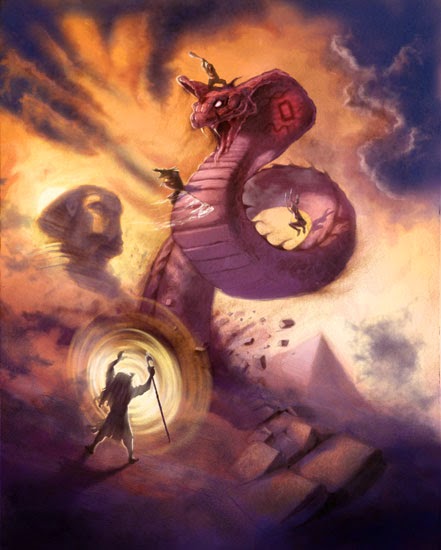 |
| Because he hated snakes |
But, ignoring the traits of being a serpent, Atum and Ra had an even greater contradiction hiding in their fusion that could only be noticed when you gathered all the stories together. The Ennead, children of Atum (and, by relation, Ra), were supposedly born of Atum as he either spat or masturbated (as he was the only entity in existence at the time). These deities were primordial forces, much like the Titans of Greek lore, and represented the essential building blocks of the natural world such as:
- Shu (air)
- Tefnut (rain)
- Geb (earth)
- Nut (sky)
- Nephthys (death, night, goth stuff)
- Osiris (life, death, ressurection)
- Isis (life and love)
- Set (that poor testicle missing god of the desert)
And because of this, we come to the most fascinating part of writing about Egyptian mythology: You can literally treat every one of these gods as a Lego block and assemble them however you please. I say this because there are so many variations of the characters in this mythology that there is no “wrong” version. Just follow this for a moment and consider that Atum is Isis’ grandfather while Horus is Isis son and BOTH of those are also Ra (or aspects of him). Because of this, Ra is either whatever someone wants him to be or he’s simply the Philip J Fry of Egyptian mythology.
Otherwise, you really can’t fuck this up!
(I write books. Normally I’d try to fill in something witty here but seeing as it was over 100 here today I’m going to assume I’ve angered the sun enough.)


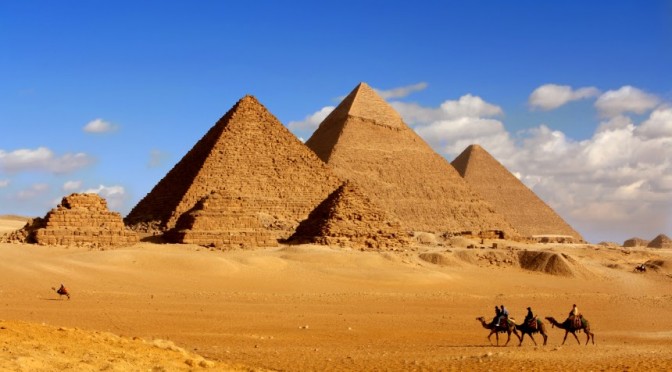
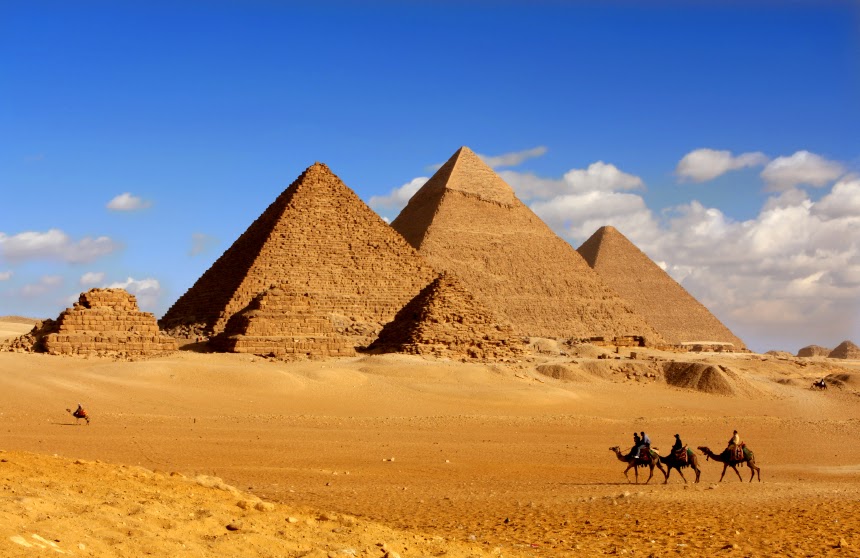




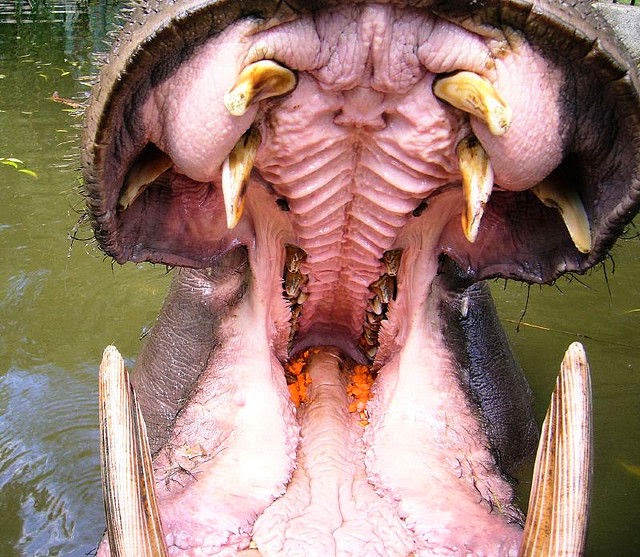
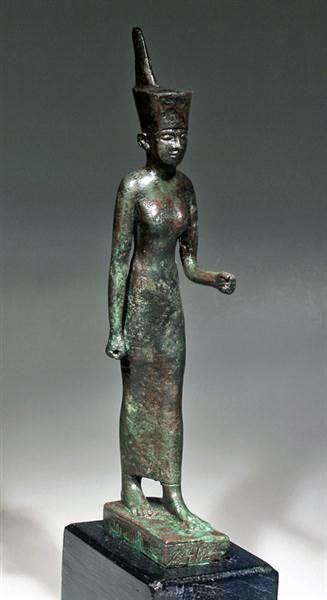
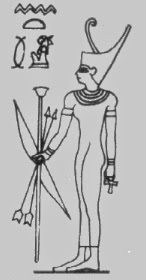
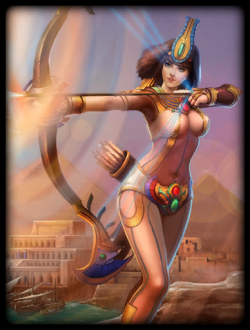

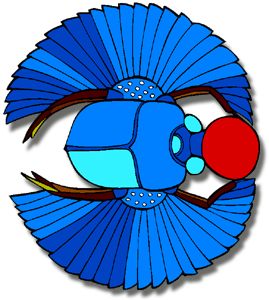
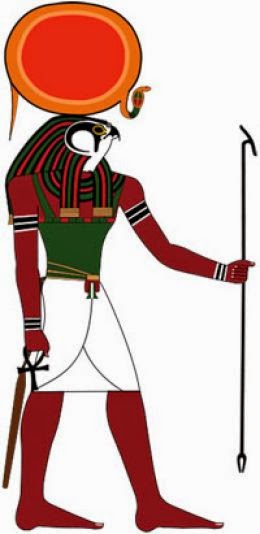

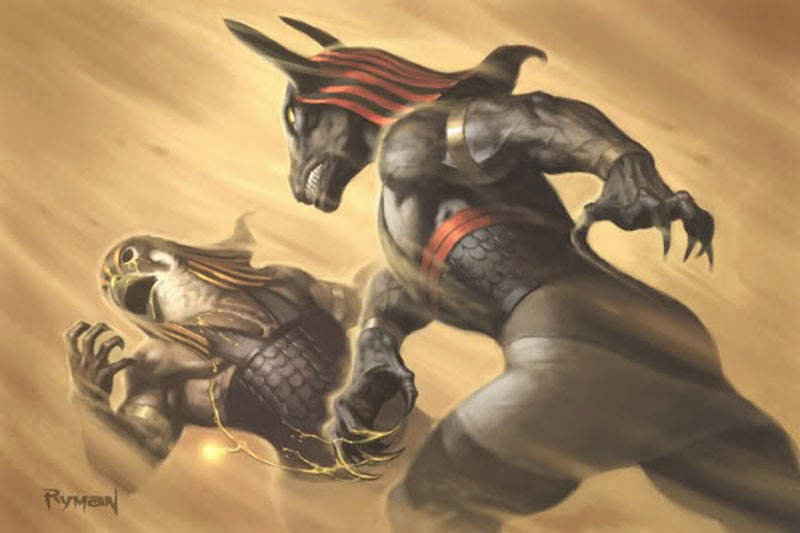
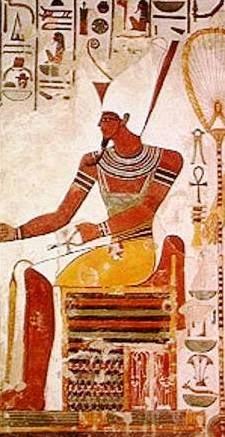





One thought on “Mythology World Tour: Lesser Known Egypt”
Comments are closed.